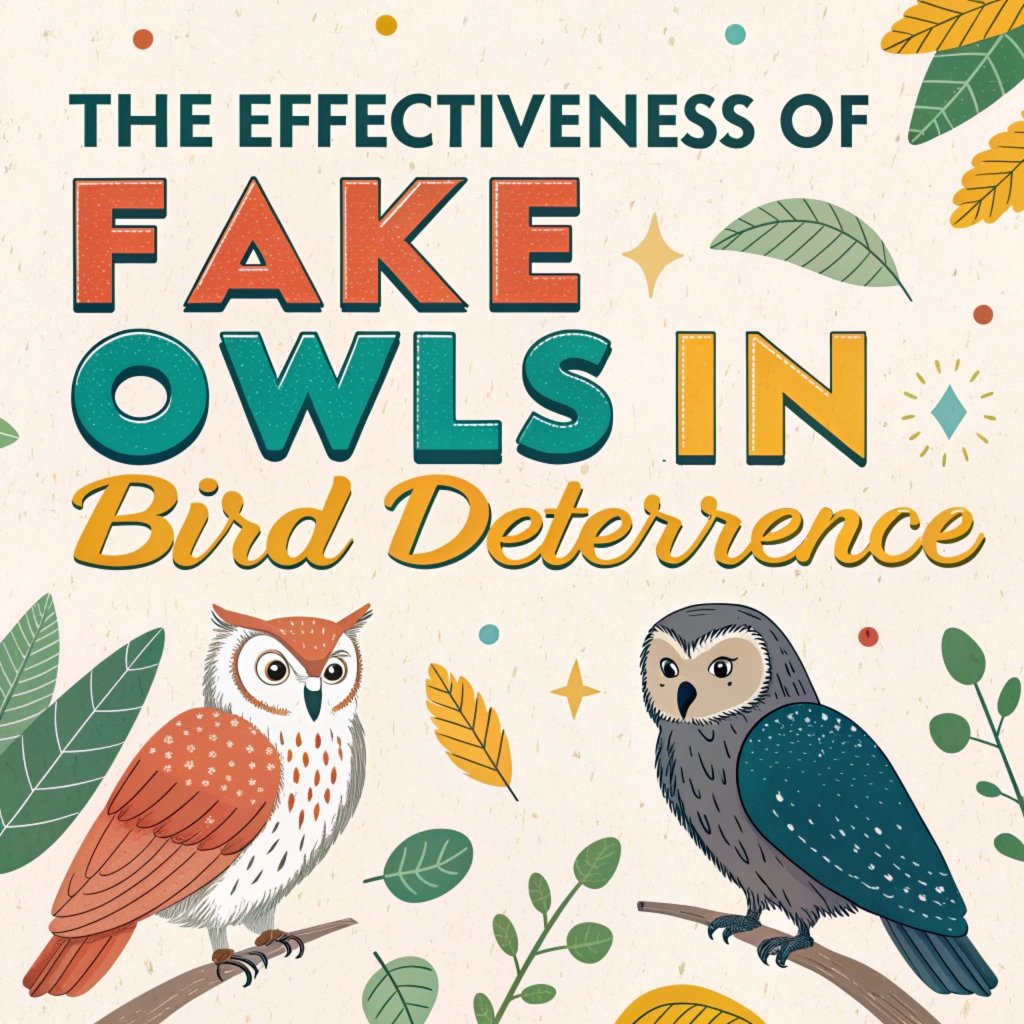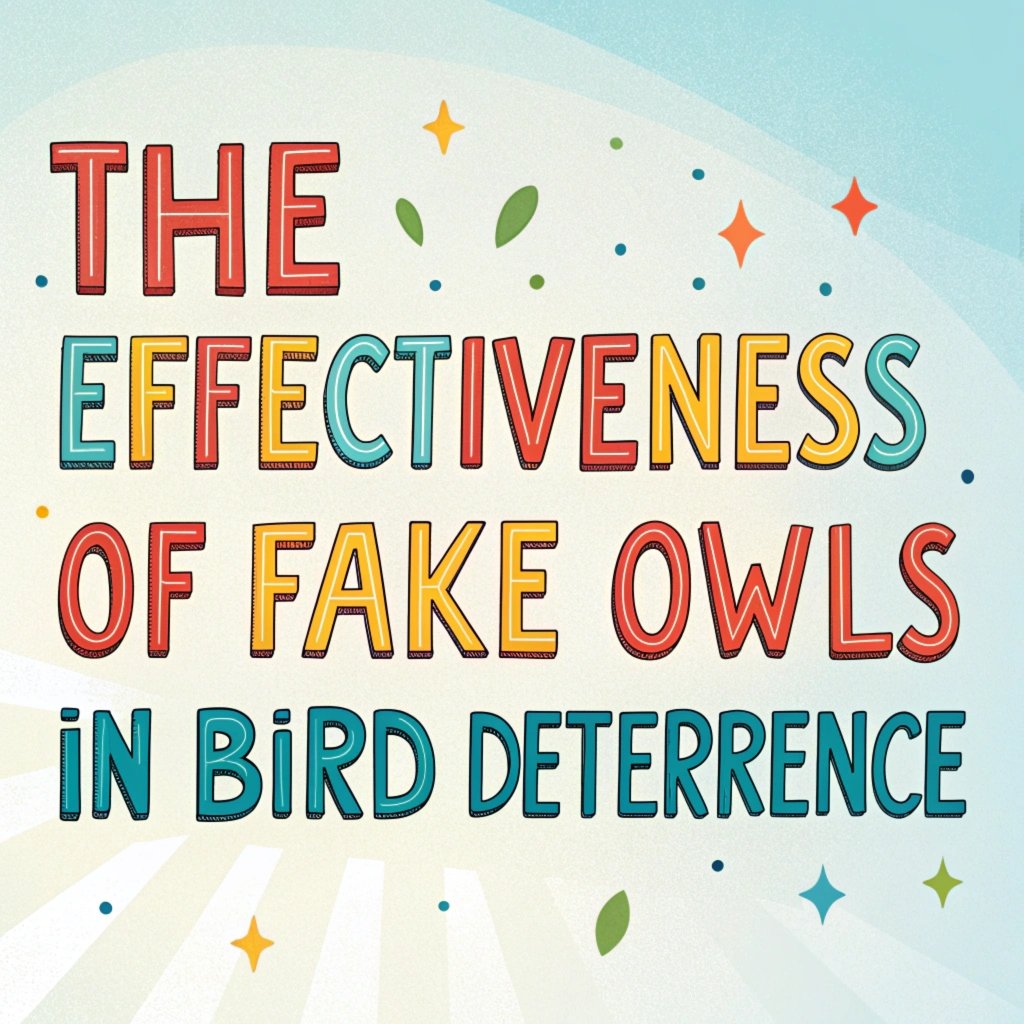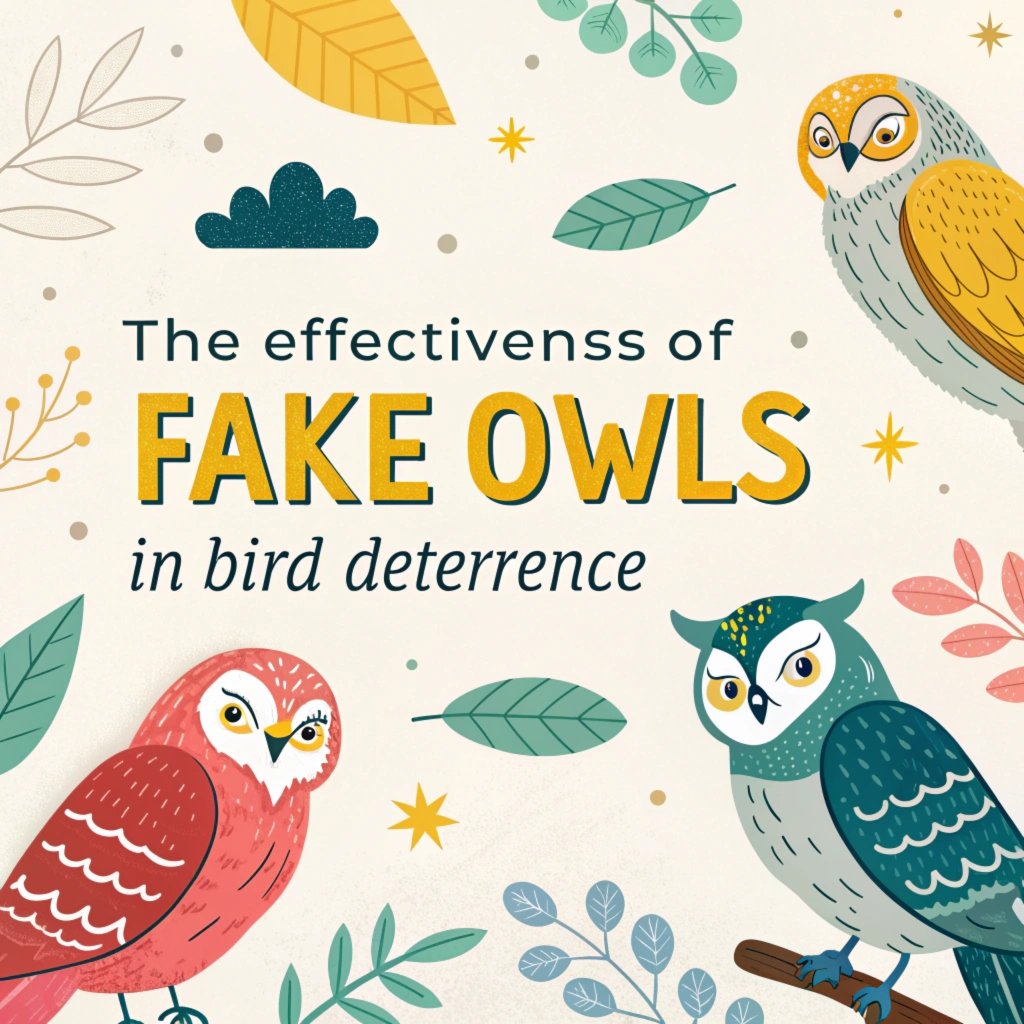The Effectiveness of Fake Owls in Bird Deterrence – A Perfect Solution
Birds can be a nuisance in various settings, from gardens to commercial properties. As a result, many people turn to fake owls as a potential solution to deter unwanted avian visitors.
These decoys are designed to mimic the appearance of real owls, which are natural predators of many bird species.
The idea behind using fake owls is to create a sense of danger and discourage birds from entering or nesting in specific areas.

Key Takeaways
- Fake owls can be initially effective in deterring birds, but their efficacy diminishes over time
- Birds are intelligent and may quickly habituate to stationary decoys
- The success of fake owls depends on factors such as placement, movement, and realism
- Combining fake owls with other deterrent methods can enhance their effectiveness
- Regular repositioning of owl decoys is crucial for maintaining their deterrent effect
- Alternative bird control methods, such as falconry and sound deterrents, may offer more long-term solutions
- Understanding bird behavior and adapting strategies accordingly is key to successful bird deterrence
The Science Behind Bird Deterrence
Understanding bird behavior is crucial when considering the effectiveness of fake owls as deterrents.
Birds have evolved to recognize and avoid potential predators as a survival mechanism. This instinct is what makes owl decoys potentially effective in the first place. Many bird species, especially smaller ones, are natural prey for owls and other raptors.
When birds encounter a perceived threat, they typically exhibit avoidance behaviors. These can include fleeing the area, emitting alarm calls to warn others, or simply avoiding the location altogether.
The presence of a predator, even an artificial one, can trigger these responses.
However, birds are also highly adaptable and intelligent creatures. They can quickly learn to distinguish between real threats and harmless objects in their environment.
This ability to learn and adapt is what often leads to the diminishing effectiveness of stationary owl decoys over time.
Types of Fake Owls Used for Bird Control

There are various types of fake owls available in the market, each designed to mimic different owl species and offer different features. Some common types include:
- Stationary plastic owls: These are the most basic and affordable options. They are typically made of durable plastic and come in various sizes and designs.
- Rotating owl decoys: These models feature a mechanism that allows the owl to rotate, creating the illusion of movement. This added feature can enhance the decoy’s effectiveness.
- Solar-powered moving owls: These advanced models use solar energy to power movements such as head rotation or wing flapping, making them more realistic.
- Inflatable owls: These large, inflatable models can be easily set up and moved around. They are often used in agricultural settings or large open spaces.
- Sound-emitting owl decoys: Some models come equipped with speakers that can play predator sounds or distress calls, adding an auditory element to the visual deterrent.
The choice of owl decoy depends on factors such as the target bird species, the area to be protected, and the budget available for bird control measures.
Initial Effectiveness of Fake Owls
When first introduced, fake owls can be surprisingly effective in deterring birds. The sudden appearance of a perceived predator in an area can cause immediate alarm among local bird populations.
This initial reaction is often strong, with birds actively avoiding the vicinity of the owl decoy.
During this initial phase, you may observe a significant reduction in bird activity around the protected area. Birds may change their flight paths, avoid landing in nearby trees or structures, and generally exhibit cautious behavior.
This immediate effect can be particularly noticeable if the area previously experienced high bird activity.
The success of the fake owl during this period is largely due to the novelty factor. Birds encountering the decoy for the first time are likely to err on the side of caution, treating it as a real threat until they can gather more information about its nature.
Factors Affecting Long-term Effectiveness

While fake owls can be initially effective, their long-term success in deterring birds depends on several factors:
- Realism of the decoy: More realistic owl models, with detailed features and natural coloration, tend to be more effective for longer periods.
- Movement: Stationary decoys are more quickly identified as fake. Models that incorporate movement, such as rotating heads or flapping wings, can maintain their effectiveness for longer.
- Placement: Strategic positioning of the owl decoy, such as in visible, elevated locations, can enhance its deterrent effect.
- Frequency of repositioning: Regularly moving the decoy to different locations can help prevent birds from habituating to its presence.
- Combination with other deterrents: Using fake owls in conjunction with other bird control methods can increase overall effectiveness.
- Target bird species: Some bird species may be more easily fooled by decoys than others, depending on their natural predators and intelligence levels.
- Environmental factors: The surrounding environment, including available food sources and nesting sites, can influence how quickly birds habituate to the decoy.
Understanding and addressing these factors can help maximize the effectiveness of fake owls as bird deterrents.
Bird Habituation to Fake Owls
One of the main challenges in using fake owls for bird control is the phenomenon of habituation.
Habituation occurs when birds become accustomed to the presence of the owl decoy and no longer perceive it as a threat. This process can happen relatively quickly, especially with stationary decoys.
Birds are observant creatures and will notice that the “owl” never moves, hunts, or behaves like a real predator.
Over time, they may even begin to perch on the fake owl itself, completely negating its purpose as a deterrent.
The speed at which habituation occurs can vary depending on the bird species and the specific circumstances.
To combat habituation, it’s crucial to regularly reposition the decoy and combine it with other deterrent methods. Some bird control experts recommend moving the fake owl every few days to maintain its effectiveness.
Enhancing the Effectiveness of Fake Owls
To improve the deterrent effect of fake owls and prolong their usefulness, consider the following strategies:
- Regular repositioning: Move the owl decoy to different locations every few days to prevent birds from becoming accustomed to its presence.
- Combine with sound deterrents: Use owl decoys in conjunction with predator calls or distress sounds to create a more convincing threat.
- Incorporate movement: Opt for owl models that feature rotating heads or flapping wings, or add wind-activated movement to stationary decoys.
- Use multiple decoys: Deploy several owl decoys in different poses and locations to create a more dynamic threat environment.
- Enhance realism: Choose high-quality, detailed owl models that closely resemble real predators in appearance and size.
- Strategic placement: Position owl decoys in highly visible locations where they would naturally perch, such as on rooftops or tree branches.
- Timing considerations: Introduce owl decoys before bird problems become severe, as they are more effective as a preventative measure.
By implementing these strategies, you can maximize the effectiveness of fake owls and potentially extend their usefulness as bird deterrents.
Alternative Bird Deterrent Methods
While fake owls can be useful, they are not the only option for bird control. Consider these alternative methods:
- Visual deterrents: Reflective tape, scare balloons, and holographic bird diverters can create visual disturbances that deter birds.
- Sound deterrents: Electronic devices that emit predator calls or distress sounds can be highly effective in scaring away birds.
- Physical barriers: Netting, spikes, and wire systems can prevent birds from landing or nesting in specific areas.
- Taste aversion: Non-toxic chemical repellents can make surfaces unappealing to birds.
- Falconry: Using trained birds of prey for bird control can be highly effective, especially for large areas.
- Habitat modification: Removing food sources, nesting sites, and water can make an area less attractive to birds.
- Lasers: Special laser devices designed for bird control can be effective, especially in low-light conditions.
- Ultrasonic devices: These emit high-frequency sounds that are meant to deter birds, although their effectiveness is debated.
Combining multiple methods often yields the best results in bird control, as it prevents habituation and addresses different aspects of bird behavior.
Case Studies: Successes and Failures of Fake Owls
Examining real-world examples can provide valuable insights into the effectiveness of fake owls:
Success Story: A community garden in Oregon reported significant success using a rotating owl decoy to deter small birds from fruit trees.
By regularly repositioning the decoy and combining it with reflective tape, they managed to reduce bird damage by over 60% during the harvest season.
Mixed Results: A study conducted at a university campus found that fake owls were initially effective in reducing pigeon populations in certain areas.
However, after about two weeks, the birds began to return. The researchers found that moving the owls regularly and combining them with sound deterrents helped maintain their effectiveness.
Failure Case: A commercial property owner installed stationary owl decoys on their building to deter pigeons. Within a month, the pigeons were observed nesting next to the decoys, completely ignoring their presence.
This case highlights the importance of using realistic, moving decoys and regularly changing their positions.
These case studies demonstrate that while fake owls can be effective, their success often depends on how they are used and maintained.
Best Practices for Using Fake Owls
To maximize the effectiveness of fake owls as bird deterrents, follow these best practices:
- Choose high-quality, realistic decoys: Invest in well-crafted owl models that closely resemble real predators in size, color, and detail.
- Incorporate movement: Opt for decoys with moving parts or add wind-activated movement to stationary models.
- Reposition regularly: Move the owl decoy every few days to prevent birds from habituating to its presence.
- Strategic placement: Position the decoy in visible, elevated locations where real owls might perch.
- Combine with other deterrents: Use fake owls as part of a comprehensive bird control strategy that includes other visual and auditory deterrents.
- Monitor effectiveness: Regularly observe bird behavior around the decoy and adjust your strategy as needed.
- Maintain the decoy: Keep the fake owl clean and in good condition to maintain its realistic appearance.
- Consider timing: Introduce owl decoys before bird problems become severe for better preventative results.
- Understand target species: Research the behavior and natural predators of the bird species you’re trying to deter.
- Be patient: Allow time for the local bird population to respond to the new perceived threat in their environment.
By following these guidelines, you can improve the chances of success when using fake owls for bird control.
Environmental and Ethical Considerations
When using fake owls or any bird deterrent method, it’s important to consider the environmental and ethical implications:
- Non-lethal approach: Fake owls offer a humane way to deter birds without causing physical harm.
- Minimal ecological impact: Unlike chemical repellents, owl decoys don’t introduce harmful substances into the environment.
- Potential stress on birds: While not physically harmful, the constant presence of a perceived predator could cause stress to local bird populations.
- Unintended consequences: Deterring certain bird species might affect local ecosystems, potentially impacting pollination or pest control.
- Legal considerations: Ensure that your bird control methods comply with local wildlife protection laws, especially when dealing with protected species.
- Balance with conservation: Consider the importance of birds in the ecosystem and aim for coexistence rather than complete exclusion.
- Avoid overreliance: Don’t rely solely on fake owls; integrate them into a broader, environmentally conscious pest management strategy.
By keeping these factors in mind, you can implement bird control measures that are both effective and responsible.
FAQs
How long do fake owls work to deter birds?
Fake owls can be effective for a few days to several weeks, depending on various factors. Their effectiveness typically diminishes over time as birds become habituated to their presence. Regular repositioning and combining with other deterrent methods can extend their usefulness.
Are some bird species more easily fooled by fake owls than others?
Yes, smaller bird species that are natural prey for owls, such as sparrows or finches, are generally more likely to be deterred by fake owls. Larger birds or those not typically preyed upon by owls, like pigeons or seagulls, may be less affected.
Can fake owls attract real owls?
While it’s unlikely that fake owls will attract real owls, it’s not impossible. Real owls might investigate the decoy out of curiosity or territorial behavior. However, they will quickly realize it’s not a real owl and lose interest.
How often should I move my fake owl?
For best results, move your fake owl every 3-5 days. This prevents birds from becoming accustomed to its presence in one location and helps maintain its effectiveness as a deterrent.
Are there any birds that fake owls won’t deter?
Some bird species, particularly larger ones or those not naturally preyed upon by owls, may be less affected by fake owls. These can include pigeons, seagulls, and some types of waterfowl. In these cases, alternative deterrent methods may be more effective.
Can fake owls be used indoors?
Yes, fake owls can be used indoors in areas like warehouses or large indoor spaces where birds might enter. However, their effectiveness indoors may be limited due to the confined space and lack of natural owl habitat.
Do fake owls work better during day or night?
Most pest birds are active during the day, so fake owls are generally more effective during daylight hours. However, if you’re dealing with nocturnal bird species, a fake owl might still be useful at night, especially if combined with other deterrents.

Hello, I’m Amelia White, the founder of birdsfanatic.com. As a lifelong bird enthusiast and spiritual seeker, I’ve always been fascinated by the mystical connections between birds and the human experience. On this site, I share my knowledge and insights into the symbolic meanings and spiritual significance of various bird species, exploring their roles in mythology, folklore, and cultural traditions. Join me on this journey into the world of birds, where we’ll discover the hidden wisdom and guidance that these magnificent creatures have to offer.







